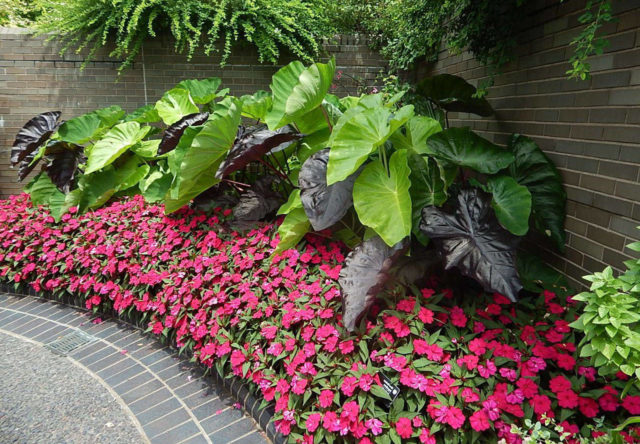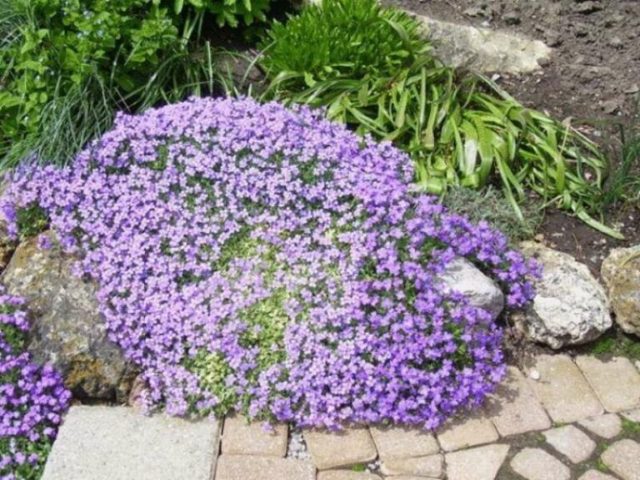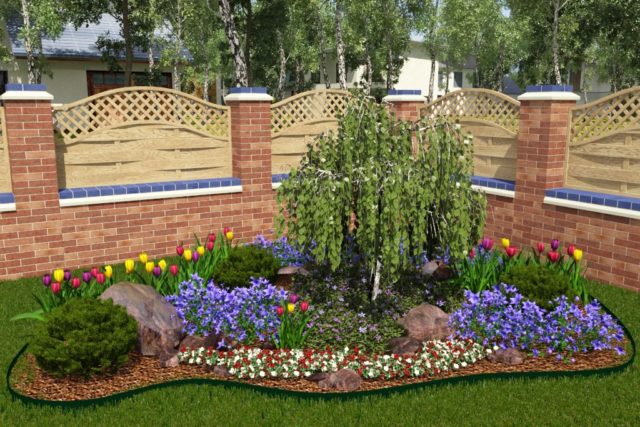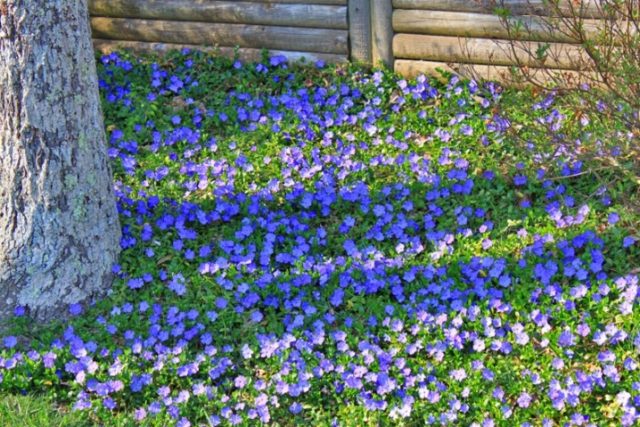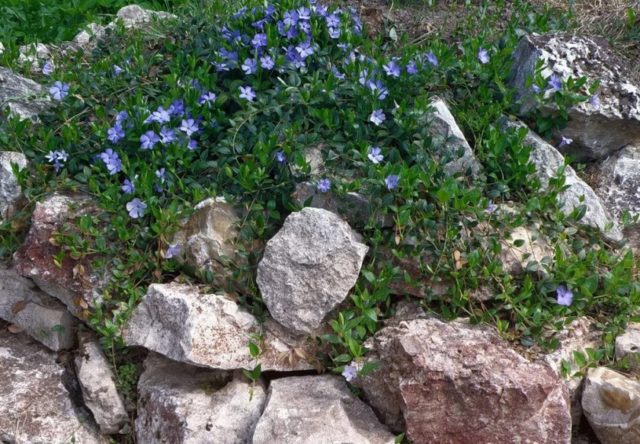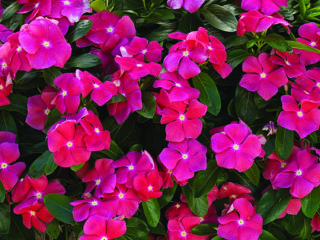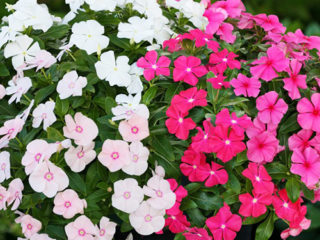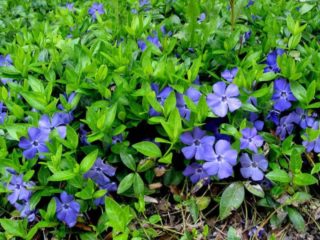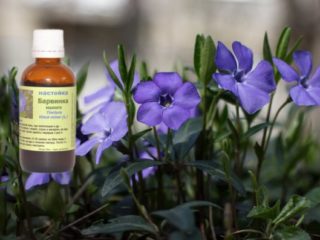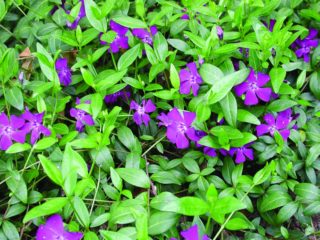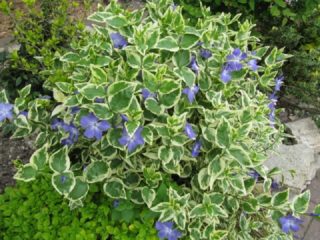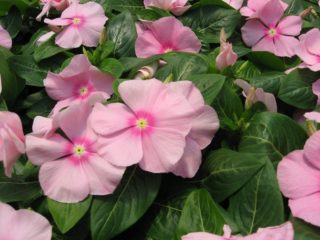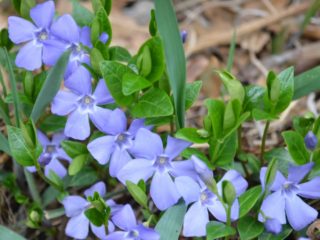Content
Periwinkle is a popular perennial plant used for decorative purposes. It is well suited for landscaping park areas, flower beds, squares, and recreation areas. Gardeners use periwinkle in landscaping primarily as a ground cover, although there are other uses.
What does periwinkle look like?
Periwinkle (Vinca) is a creeping evergreen. This is a low perennial shrub from the Kutrov family. It grows wild quite often in Eurasia; some species also grow in North America. The shrub owes its name to the Latin word “vinca”, which means to creep or entwine.
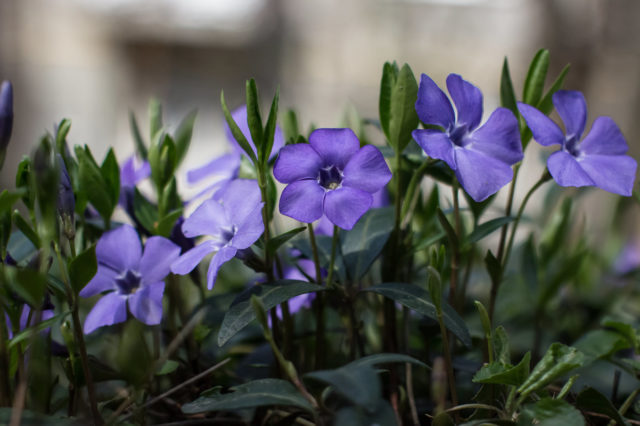
Numerous creeping stems of the plant quickly take root, forming a continuous carpet
Periwinkle is a real boon for the lazy gardener. This plant has truly unique properties. It is quite decorative, grows without any care, reproduces easily and lives for a very long time. In addition to everything, it has a number of useful properties, is used in folk medicine, and is also used in various magical rituals.
In appearance, periwinkle is a small, low shrub that grows in a continuous carpet. It has tough stems and dark green small leaves. In spring, the plant develops flower stalks, on which buds with petals of a soft purple color bloom. They can please the eye throughout the summer and into late autumn.
The most beautiful types and varieties
There are quite a few varieties of periwinkle. Depending on their size, they are divided into several groups, each of which includes varieties with different colors.
Periwinkle
This variety of periwinkle has the Latin name Vincaminor. The plant is evergreen, with a twining stem. The leaves are a rich dark green color with a gloss; there are also varieties with a variegated color, with a silvery tint, with a border of varying tones from yellow to red. Their shape is oval-elongated with a sharp tip. Peduncles can grow up to 15-20 cm. Flowering is short-lived, occurring in May-June. The color of the petals ranges from white to purple. The corolla has 5 petals.
Bowles's Variety
This variety is distinguished by its large soft lilac flowers. The leaves of Bowles Variety are rich green, glossy, dense, rather small, with clearly visible veins. The height of the plant can reach up to 30 cm. The peduncles and some of the shoots are erect; in addition to them, the plant has a large number of creeping stems, thanks to which a continuous green carpet is formed.
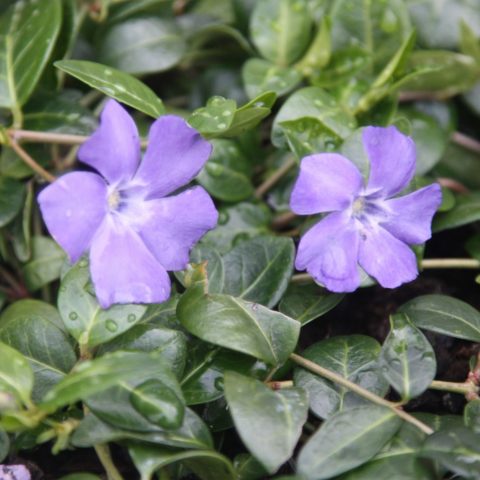
Bowles' Variety buds appear in late spring and may occasionally rebloom
Darts Blue
Darts Blue is a low variety of small periwinkle, it rarely grows above 20 cm. It got its name for the rich blue color of the petals. The leaves are small, glossy, bright green, dense.
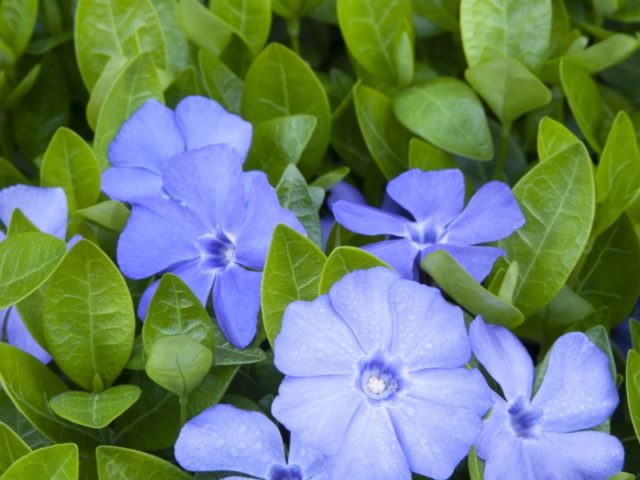
Darts Blue blooms in early spring, less abundantly in summer
EmilyJoy
Emily Joy has a pure white flower corolla and petals. The leaves are quite large, elongated-ovate, glossy, green with a yellowish tint.
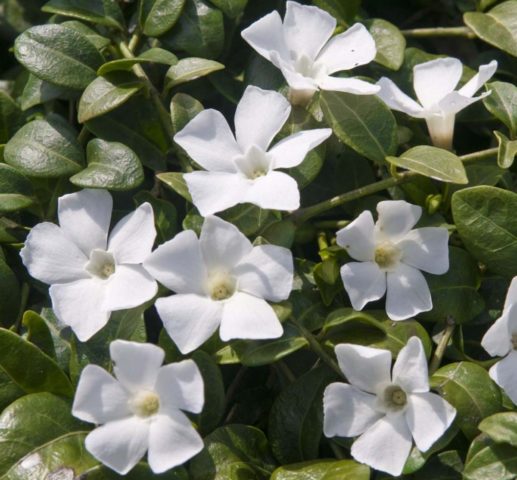
Variety Emily Joy is quite young
Marie
This is a low-growing variety, excellent for creating continuous cover. The stems are creeping, long, and take root well. The leaves are dense, leathery, bright green. The flowers are small, about 2 cm in diameter, violet-blue, appear at the end of May
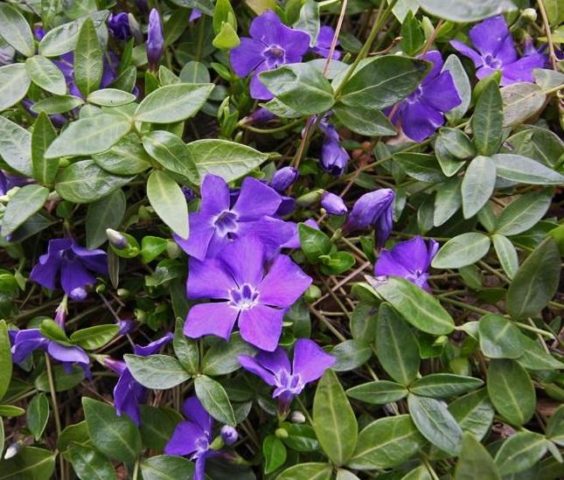
Often in September there can be a second wave of Marie flowering
Atropurpurea
This variety is distinguished by its original flower shape, reminiscent of a propeller. The color of Atropurpurea petals is purple. The stem is flexible and creeping. The leaves are quite small, green, with a glossy sheen.
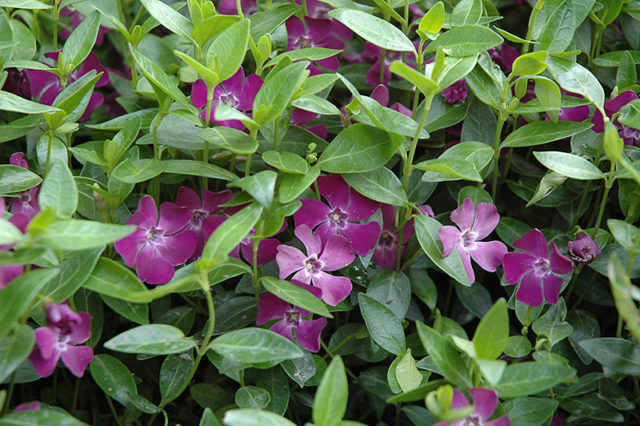
The variety Atropurpurea blooms in May-June
Large periwinkle
In Latin this variety is called Vincamajor. These are mainly creeping plants of small height with a creeping stem and large leaves and flowers, reaching 5 cm in diameter. In ornamental gardening, large periwinkle is used much less frequently, since the number of flowers on its bushes is much smaller than on small ones.
Variegata
This is one of the most popular varieties of periwinkle. Variegata leaves are large, green, with a light border of a milky greenish tint. The flowers are large, purple, rare.
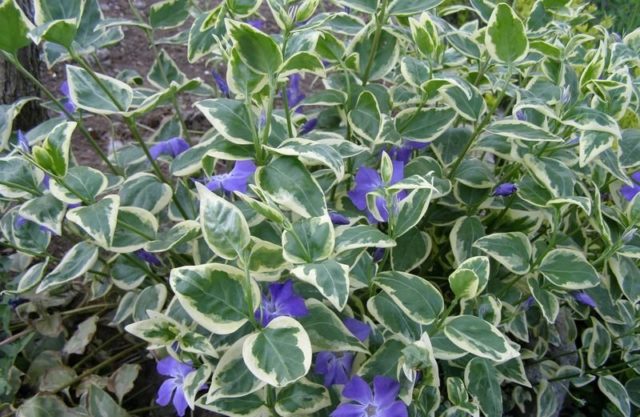
The height of Variegate can reach 30 cm
Maculata
Periwinkle major Maculata has a characteristic leaf color. Their interior has an irregular yellowish patch and appears lighter against the bright green. The flowers are few, large, purple, lighter in the central part of the corolla.
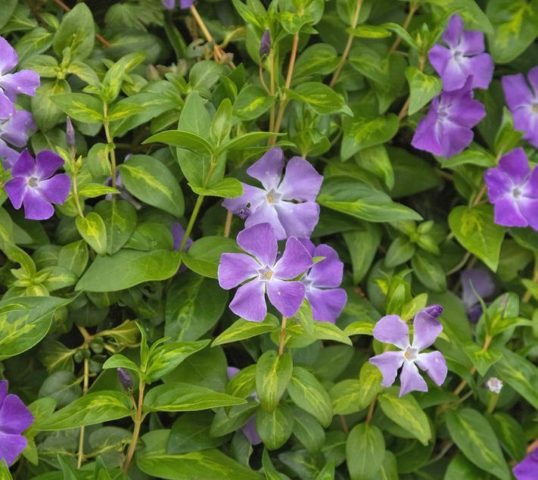
The Maculata variety has a lighter central part of the leaf.
Periwinkle pink
Vinca rosea is the Latin name for this variety of periwinkle. It happened because of the characteristic color of flower petals. The main difference from other species of this plant is its erect stems. Another characteristic feature is the long flowering period; buds appear in the spring and do not disappear until late autumn.
Grape Cooler
The variety is distinguished by very decorative lilac-pink flowers with a light center. The plant has dense, leathery, round-ovate leaves with a light central vein.
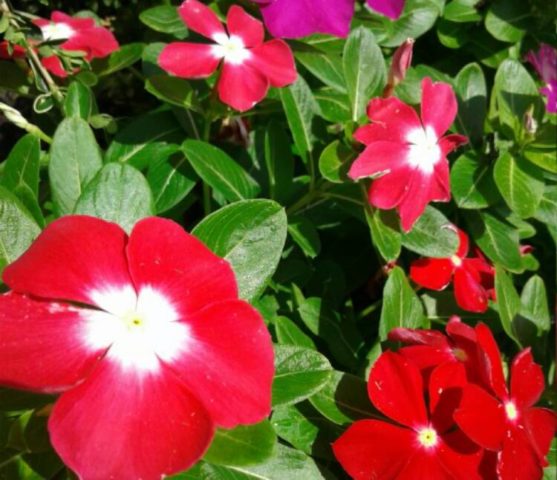
The height of the Grape Cooler bush can reach 60 cm
Peppermint Cooler
This variety has flowers painted pink, while in the center it is more saturated and resembles a slightly spread bright crimson-red blot. The Peppermint Cooler plant has green, large, oval-oblong leaves and a strong stem.
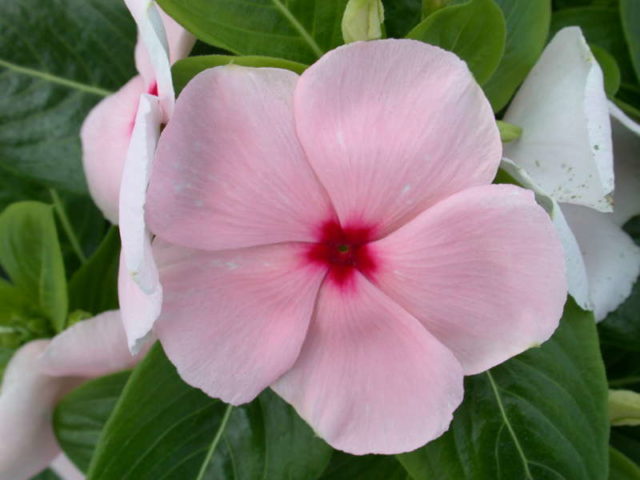
A bright, blurry spot in the center of the flower distinguishes the Peppermint Cooler variety
How to design a flower bed in the garden
Periwinkle is used mostly as a ground cover plant, forming a continuous carpet. Creeping stems take root easily, so the bush very quickly grows in width, becoming denser and covering ever larger areas. Here are some of the options for using periwinkle as a decorative element in the garden:
- Border. Periwinkle is great for edging paths and alleys.
After flowering ends, the red border will turn green
- Alpine slide. A green carpet with many small flowers looks very impressive among the stones.
A flowering stream flowing around the stones looks very impressive
- Mixborder or combined flower beds. Periwinkle combines well with other, larger plants, so it is often used in various floral arrangements or backgrounds.
Periwinkle looks great in mixed plantings
- Substrate. Often these plants are planted under fruit trees instead of the usual grass lawn.
A flowering carpet is an excellent alternative to a regular lawn.
- ABOUTformation of steep slopes. Periwinkle is often used not only for decoration, but also to strengthen and hold the soil on a hill or hill.
The plant perfectly strengthens slopes
What colors does it go with?
Periwinkle looks good in individual plantings, but it is not an antagonist and gets along well with many other plants. In mixed compositions it is planted next to ferns or violas. Often its neighbors are cereals and bulbous plants: tulips, crocuses, irises, lilies.
Here are some photos of which group plantings you can use periwinkle in:
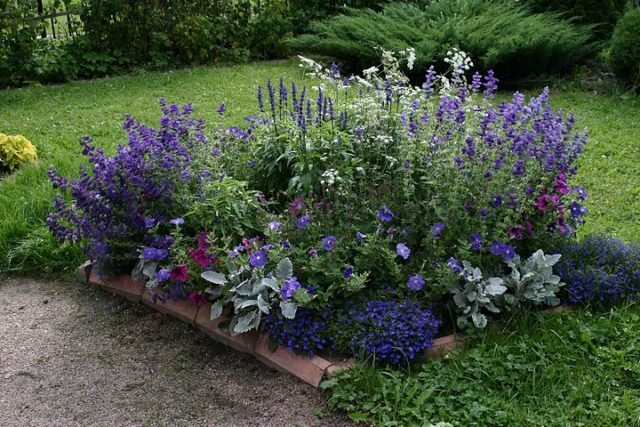
A flowerbed in blue tones is an ideal combination for decorating a site
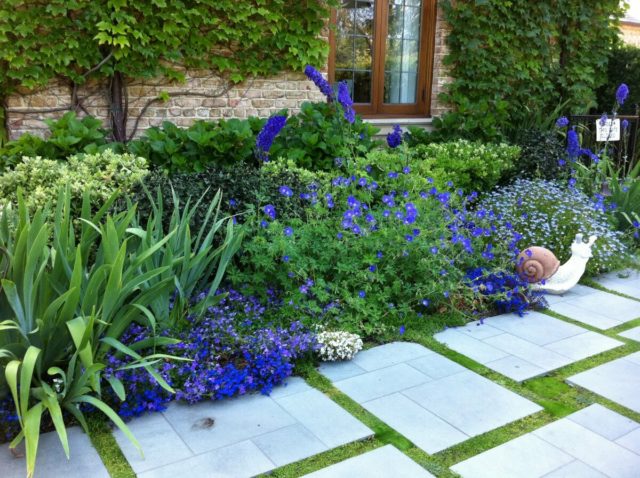
Mixborder in combination with irises and other flowers will adequately decorate the path
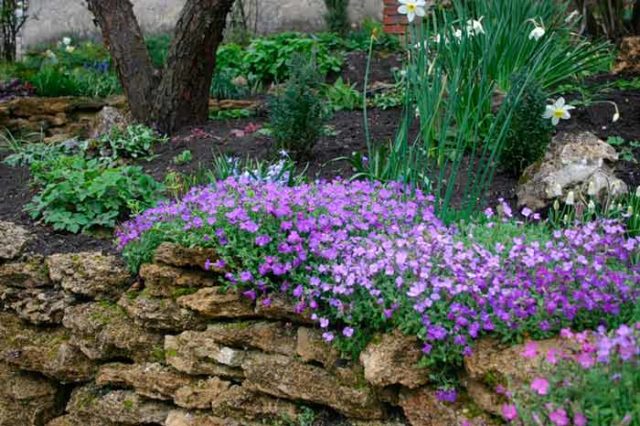
The alpine landscape harmonizes perfectly in combination with daffodils
Conclusion
Periwinkle in landscape design can be used for a variety of purposes. It is unpretentious and undemanding, while its decorative effect remains even after flowering has ended. An additional advantage is that the plant has good frost resistance and can be grown in many regions without shelter for the winter.
